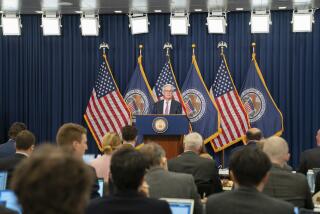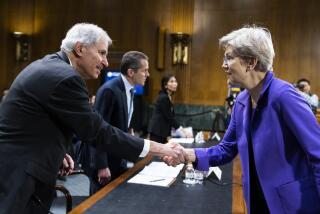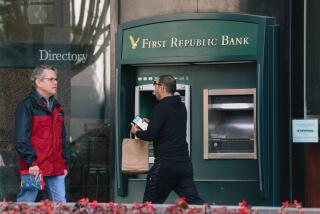Seidman Defends Bank Lending Policies : Finance: The slowdown in loans is primarily a result of lower demand caused by the recession and debt taken on in the ‘80s, the outgoing FDIC chief says.
- Share via
SAN FRANCISCO — In his final visit to the banking industry’s annual convention, maverick regulator L. William Seidman took a subtle swipe Monday at recent suggestions by President Bush and other Administration officials that overzealous regulators are to blame for cautious bank lending.
“If it’s your patriotic duty to make good loans. . . then it’s equally your duty to God and country not to make bad loans,” Seidman told members of the American Bankers Assn., the industry’s main trade group.
In a dinner meeting with reporters Sunday night, Seidman made the same point, saying that although tough banking regulators may have contributed somewhat to the “credit crunch” by intimidating lenders, they are not the primary cause of the lending slowdown.
The reason banks are not lending more, he said, is because demand for loans is down, caused by the recession and the huge amount of debt companies and consumers took on in the 1980s.
The role of bank and thrift regulators in bringing about the credit crunch has been debated during the past two years in the industry, with no clear consensus reached. The debate gained new life during the past two weeks when President Bush, frustrated over the economy’s sluggishness, put the spotlight on regulators for being too overbearing in some cases.
Critics of regulators, often citing anecdotal evidence, contend that regulators have made lenders gun-shy about making loans to good customers. But other experts argue that the reluctance to lend is normal, and even prudent, in a soft economy, especially given the deteriorating commercial real estate market.
Seidman, whose term expires Oct. 16, is chairman of the Federal Deposit Insurance Corp., which insures bank and thrift deposits, and Resolution Trust Corp., the government’s thrift cleanup agency founded in 1989. He is scheduled to be replaced at the FDIC by William Taylor, a Federal Reserve Board official, and at the RTC by former American Airlines Chairman Albert V. Casey.
In his five years as a bank regulator, Seidman, 70, has presided over what many believe is the industry’s worst crisis since the Great Depression. The insurance fund protecting bank deposits is nearly broke, and problem real estate loans continue to threaten the health of many banks.
Seidman became one of the few bank regulators to achieve celebrity status, his bald pate a fixture at televised congressional hearings and on interview programs.
Seidman’s speech to the bankers’ group was sprinkled with the kind of dry humor that made him popular with Congress and the press during his six years in Washington. He titled his speech “The Fourth Annual Farewell Address,” a tongue-in-cheek reference to unsuccessful efforts in the past by some Administration officials to pressure him into leaving early.
Making light of his outspoken style, which often caused friction with the Administration, Seidman described Washington as “a place where being a team player can mean ‘shut up and sit down.’ ”
Seidman told reporters that the Bush Administration is working on various proposals to deal with the credit crunch, but he would not provide details, saying he only glanced at the plan and will not get involved with it because he is leaving office soon. Among the things the Administration is known to be working on is a special appeals procedure for banks unhappy with their regulatory examinations.
More to Read
Inside the business of entertainment
The Wide Shot brings you news, analysis and insights on everything from streaming wars to production — and what it all means for the future.
You may occasionally receive promotional content from the Los Angeles Times.










